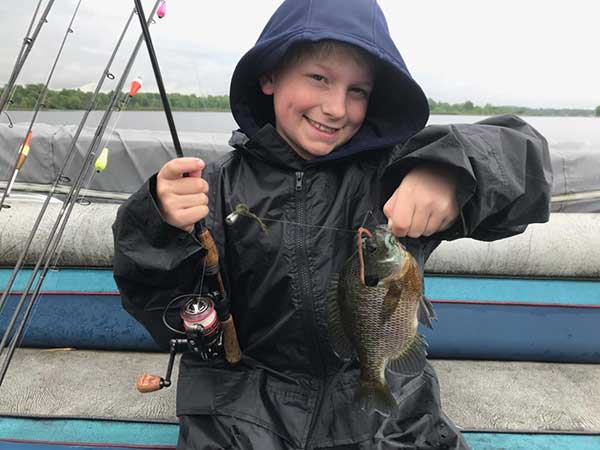By Louie Stout
 Bluegill Spawn Has Been a Good One
Bluegill Spawn Has Been a Good One
Gotta love those bluegills.
Everyone who has ever dangled a worm in Michiana waters knows how much fun they can be to catch – and equally good to eat.
Especially this year.
It’s the bluegill spawning season throughout the area and bluegills can be caught on just about every body of water.
It’s been that way for a couple of weeks, and according to Darrin Schaap, this might be the best spawning season he’s ever seen.
“I’ve never seen this many bluegills come up at once,” said Schaap, the owner of Clear H2o Tackle in Edwardsburg and one of the most avid bluegill angler in the region. “It’s starting to taper off but still remains strong.”
Bluegills spawn in waves, with the first being the biggest. There will be subsequent spawns over coming weeks, especially around full moon periods, and some bluegill spawn into July. Deeper, colder lakes run a little behind the shallower lakes.
“The first wave occurs in the most obvious places and often in the same places every year,” said Schaap. “Hot spots are sand or gravelly areas, reed beds or even clam beds. They usually spawn around some cover, like lily pads and other vegetation, but typically on a harder bottom.”
Avid bluegill anglers know those areas and pluck off the fish as soon as they appear on beds. But they can’t get them all.
“What’s odd,” said Schaap, “is that some fish will finish or be taken off those bedding areas and new ones will move in to take their places.”
Another oddity about this year, he added, is the spawning areas are rarely bigger than 50-yard swaths but this year he’s seeing beds spread over a 125-yard flat.
Once you find them, you can catch them with any simplistic method. Most anglers like to drift a livebait under a fixed or slip bobber over the beds, but Schaap believes there are better ways.
“I fish with my kids all the time and the bubble bobber works best,” he said. “You can add a tiny split shot on there, but it can be better to fish without a sinker, and let the worms fall slowly and drift naturally over shallow areas, especially if there is a gentle wind to push it along. The adjustable bubble bobber makes it easier for kids to cast.”
Bait choices are numerous. You can use a wet fly tipped with a wax worm, but Schaap has seen days when tiny synthetic live baits like Berkley Power Bait or Gulp catch them as well as true livebait. However, his favorites are small leeches, red worms or one-half nightcrawlers.
Overharvest?
With so many vulnerable bluegill spawning simultaneously, can angler pressure hurt a lake by taking so many fish? Michigan limits anglers to a 25 fish a day limit while Indiana has no limit.
“I honestly believe it happens so fast and there are so many fish up spawning that anglers can’t get them all,” said Schaap, who fishes southwest Michigan.
Furthermore, many spawning bluegill will bed in remote or deeper areas of the lake and go unnoticed by anglers so eager to find them shallow.
“Redears and pumpkinseeds tend to prefer spawning in warmer water,” Schaap explained. “Bluegills will do that early in the spawning season, but when the water warms up they prefer to spawn deeper.”
That’s when bluegills will spawn in the 8- to 10- foot depths on some lakes, but the bottom has to be slow tapering and sandy, gravelly or clay. They don’t like to spawn on mucky bottoms.
“They can be hard to find unless you have electronics with side imaging,” he said. “With that, you can see the saucer-like marks on the bottom and maybe even see fish around them.”
When bluegills go deep, the best way to find them is to drift through an area with a half nightcrawler threaded on a No. 6 Aberdeen hook and a No. 5 or 7 split shot a foot above. You can use a bobber, but Schaap prefers to go without it most of the time to keep the sinker bouncing on the bottom through potential bedding areas.
“Some guys also prefer smaller hooks but the 6 makes it harder for the fish to swallow it and easier to unhook,” he said. “I also prefer the round split shot (without “ears”) because they don’t catch in the weeds as easily.”
While most anglers insist dainty line gets you more bites, Schaap says he gets just as many with 8-pound monofilament as he does 4 or 6 sizes.
“Besides, you don’t break off as easily on snags and you may catch something around bluegill beds that is a lot bigger,” he said.





